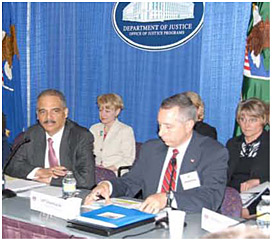

Attorney General Eric Holder chaired the April 16, 2010, meeting of the Coordinating Council on Juvenile Delinquency and Justice Prevention. With him are Jeff Slowikoswki, Acting OJJDP Administrator (right); Laurie Robinson, Assistant Attorney General for the Office of Justice Programs (second row, left); and Melodee Hanes, Counselor to the Administrator and Acting Deputy Administrator for Policy, OJJDP (second row, right).
At the April 16, 2010, meeting of the Coordinating Council on Juvenile Justice and Delinquency Prevention, teams staffed by the Council's member agencies presented their workplans for assessing federal practice in four areas: education and at-risk youth, tribal youth and juvenile justice, juvenile reentry, and racial and/or ethnic disparities in the juvenile justice system and related systems. The Council identified these priority areas at its January 2010 meeting.
The teams are analyzing policies, legislation, regulations, and practices that foster as well as hinder achievement of federal goals in partnership with states, tribes, and units of local government, and will develop recommendations for consideration by the Council agencies. Approved recommendations will be incorporated into the Council's 2010 Annual Report to Congress.
Attorney General Eric Holder, who chaired the meeting, emphasized the significance of the teams' work. "These issues are of critical importance to the nation and of importance to me personally," he said. "We appreciate the challenge of this work . . . and all that people are doing."
Following are brief summaries of the teams' reports:
- Education and at-risk youth. Team members will assess the impact of federal policy and legislation on chronic truancy, educational instability, access to educational opportunities in juvenile detention, co-occurring factors such as learning disabilities and emotional problems, the need for school connectedness, and the availability of positive afterschool activities.
- Tribal youth and juvenile justice. This team will focus its initial efforts on reviewing policy and practice in relation to prevention, intervention, detention, and reentry among tribal youth. The selection and assessment of this subset of issues is the beginning of an ongoing effort to identify problems that impact federally recognized tribes and to review and improve federal policy and practice.
- Juvenile reentry and transitions to adulthood. Among the issues this team will examine are how youth-serving agencies can more effectively engage the education, health, housing, and workforce development systems in collaboration with businesses, nongovernmental organizations, faith communities, the media, and local neighborhoods in reducing recidivism among youth reentering their communities.
- Racial and/or ethnic disparities in the juvenile justice system and related systems. Through interviews with stakeholders in the juvenile justice, child welfare, and education fields and an extensive review of empirical research, literature, and grantee reports, this team will assess the impact of federal policies and practices on disproportionate minority contact. Major areas of focus will be the role of the child welfare system, education, and youth's socioeconomic status.
The Council meeting also included presentations on the following topics:
- OJJDP's Juvenile Information Sharing Initiative, the first national project to help youth-serving agencies form community collaborations and use advanced technology to effectively share information about the needs of at-risk youth across a broad range of systems, including social services, medical and mental health, education, and juvenile justice. Quick access to this information helps youth-serving agencies effectively determine the most appropriate supervision, services, and sanctions for youth. For more information on the initiative, please read the article entitled "National Juvenile Information Sharing Initiative" in this issue.
- Attorney General's Access to Justice Initiative, launched on March 1, 2010. Laurence Tribe, a national authority on constitutional law who is heading up the project, will serve as the primary liaison to the federal judiciary and work with federal, state, and tribal judiciaries to improve indigent adult and juvenile defense, enhance the delivery of legal services to the poor and middle-income families, and identify and promote effective alternatives to incarceration. At the Council meeting, Tribe said two current areas of focus affecting youth in the juvenile justice system are improving access to counsel for unaccompanied minors in deportation hearings and reducing the number of juveniles who waive their right to counsel in juvenile delinquency proceedings. "There is no such thing as a just society that turns its back on justice to the young," Tribe said.
- Attorney General's Children Exposed to Violence Program. On March 31, the U.S. Department of Justice announced more than $5 million in available funds to address the high incidence of American children's exposure to violence. The Department has made these funds available through six grants solicitations targeting planning, outreach, research, and best practices. The funding is available through solicitations administered by the Office of Justice Programs' National Institute of Justice, OJJDP, and Office for Victims of Crime.

